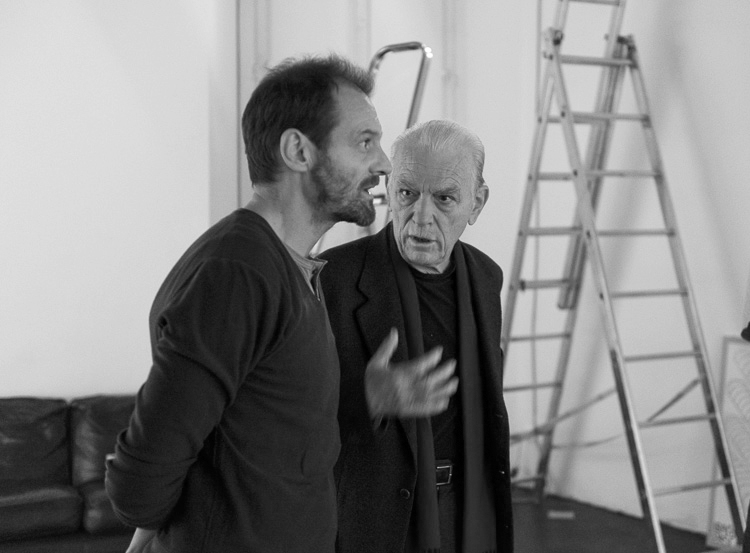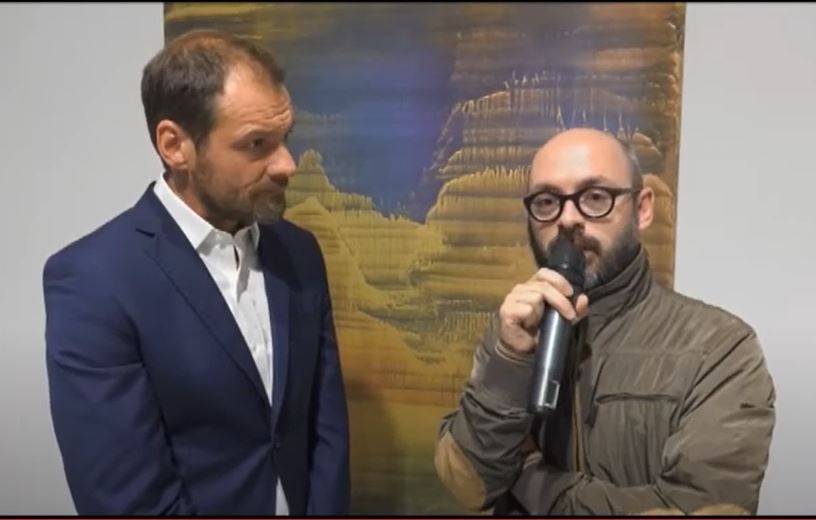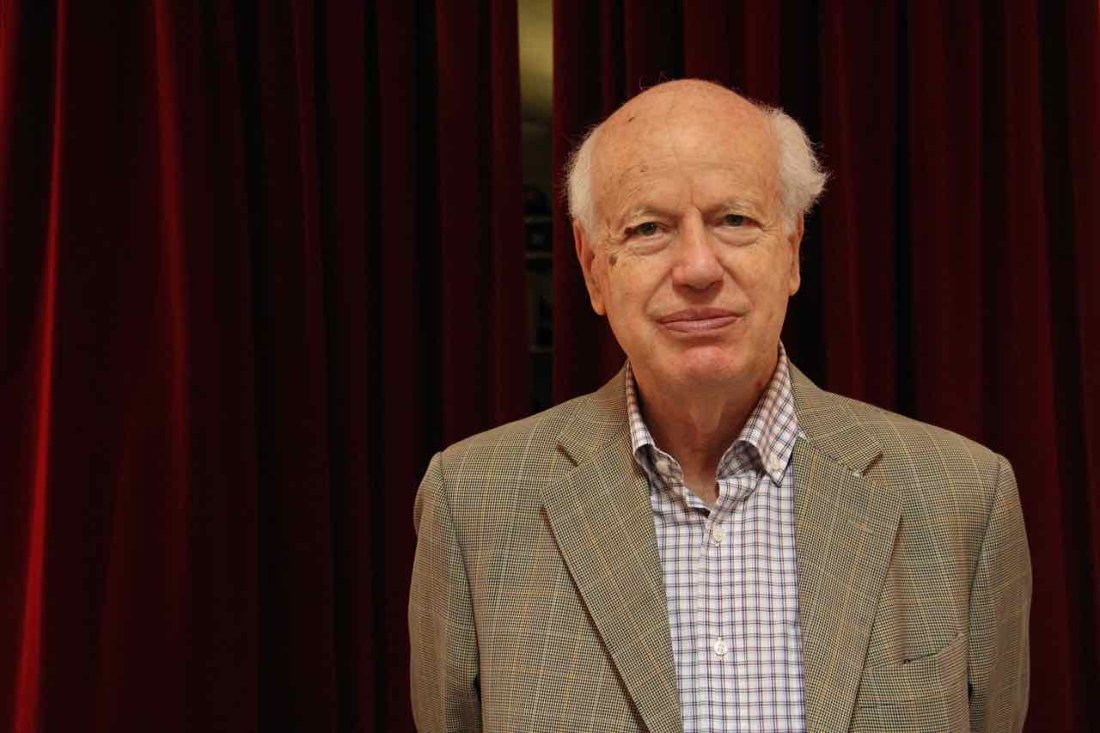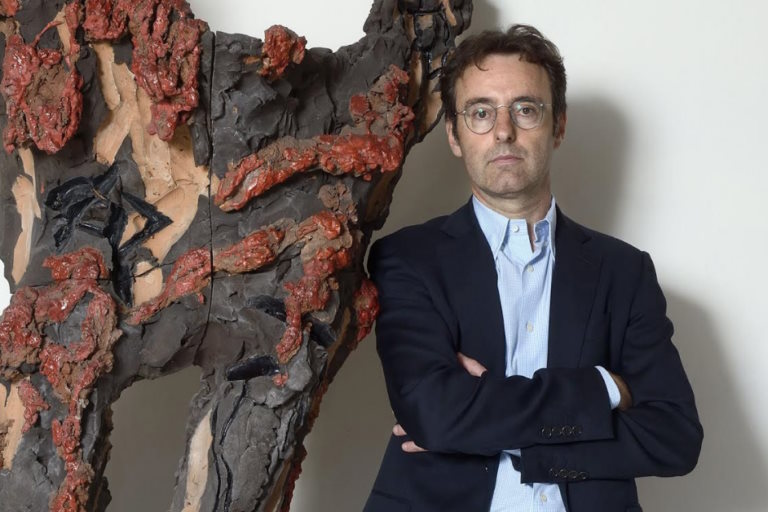
Middle of the summer, between July and August.
l'm receiving regular e-mails from Matteo with pictures of the paintings he's working on. l'm mulling over the undeniable growth of his works. As Matteo keeps me updated, on his progress, l'm starting to jot down a few thoughts on a notebook. Here they are.
Matteo's poetics are based on the compelling urge to ascend. Throughout his artistic life he has been chasing down the sky, making it his own, losing it, then conquering it again. And after a long time, the most difficult part lies precisely in the possibility of capturing the lost sky again.
In his attempt to do so, the painter has had to plunge into the neverending blackness of the night, where the infinte suffering of the world, along with his own, lies.Yet the emerging line of the horizon is already the promise of a landscape ...
While the outline of boiling lava materializes before our eyes, what could these little peaks, so dear to thc painter, represent, if not fleeting tongues of fire coming to life for an instant, like lost souls in search of redemption?
In the part of these recent paintings dedicated to the sky, for the first time curvy and shapely figures appear: They are the results of an original, fresh, circular, fluid brushstroke, giving life to a marching troop of redness invading the sky, to a choir's song reverberating in the firmament. I ask myself: who are they? What hare they come to tell us? Kandinsky's red sound comes to mind: a sound which does not talk about blood but conveys the drama of sorrow.
Late September.
lt's time for me to go to Matteo's studio in Nepi to make the final selection of the paintings for the exhibition. I have already seen them on the photos he sent me during the summer, but stepping into the heart of thc place of creation always makes for a thrilling encounter:
He calls me on the phone:
- Shall I pick you up at the usual place?
No need to say which place: near the bridge across Lungotevere, the same place we used to meet ten years ago when we were preparing the first exhibition. lt's nice to see that old habits clic hard. Like an unbroken fil rouge between us.
Fabio Sargentini, Rome 6th of November 2016
Montani lets the very liquid painting drop at an accelerated rate and redefines the backdrop of the paper on which he works, a backdrop made of silicon and carbon monoxide, as a “horizon of events”, citing the definition that scientists give of that area of the black hole beyond which, to date, we know nothing of what happens. Painting is a transcendent operation that determines unexpected events until it reaches a middle moment in which the break between the sensitive and the ultra-sensitive world heals…”
“His paintings conjure dawn, sunrise, and sunset. His whole opus is located in-between, in that “between” where the vapors of Chinese painting are released, in that landscape/passage (“paysage/passage” in French). The moment is that of the transition, of the passage, simple, and absolutely mysterious”.
Laura Cherubini, Art historian, Brera Academy of Fine Arts, Milan; Flash art International contributor

“It is by lending his body to the world – reminds Merleau-Ponty – that the painter transforms the world into a painting. In order to understand this transubstantiation, we must see the body as operational and effective, not as an area of space, a stack of functions, but a web of vision and movement.” In this way, Montani establishes his own pictorial vocabulary, a condensed poetic language, which is simultaneously essential and visionary, distinguished by an ancient and primitive dimension, it becomes a code and language: reminiscent of an ideogram, it becomes pictorial shorthand, a metamorphic series of visual clues. In this way, his evanescent landscapes emerge amongst mist and apparitions, they almost become painted holograms, brought to life with a binary colour contrast: the sandpaper background and the epiphany of pure colour, which appear like a dance, where upward movement can be glimpsed.
The visual architecture is organised according to a system of signals and information where the natural forms appear to autogenically hatch, in the same manner as a biological excrescence which preludes birth, as the developments of thoughts. The fluid colour masses, with loose delimitations, hardly appear at the “edge” of the work: blurry, inconstant lines, at times denser and heavier materi-al-based, appear vague across the painting surface, in their quest to settle, to find a balanced entropic force."
Eugenio Viola, Chief Curator of Mambo Museum, Bogotà, Colombia; Curator of the Italian pavillon at La Biennale di Venezia 2022

In the beginning was the image. Yes, the image, and not the word. The miracle of those mischievous and effective linguistic shifts that Gino De Dominicis, an artist able to materialize words into images, often used to turn verbal into visual with disarming readiness and ease. In principio era l’immagine [In the beginning was the image], stated the title of one of his works in the early 1980s. Indeed, when one approaches a work of art, everything begins with the image. Words can only ramble: describing, suggesting, evoking an approach that remains visual.
In the works of Matteo Montani, the image asserts its centrality in silence. It seems to self-generate, then undergo unending transformational processes that put its initial and final arrangement in question. The artist first undertook this journey in painting but, this time, expands it to the language of sculpture; in Unfolding, it takes place in different moments and places (the upper vestibule of the Royal Palace of Caserta, the Nicola Pedana Gallery), drawing on prompts and experimentation from the past and simultaneously pushing forward to a new dimension.
Alessandra Troncone, Professor of Art History at the Academy of Fine Arts in Naples; Artistic Co-Director of Underneath the Arches, Naples; Curator and Researcher

You would normally expect a critique to ‘shed light’; to provide clarity on the artist’s research. The very same light that shines out in Montani’s works. I’ve been observing them for quite a few days now and the more I try to translate it into words, the more I realize it evades me. It’s almost as if there’s an abyssal divide that’s threatening to suck me in. Kierkegaard said that “If you gaze for too long into an abyss, the abyss gazes also into you”, and I have the distinct impression that this is also what happens with these paintings…
…Using vaporization and drips, the artist negates matter of its mass, converting it into energy – or an ‘idea’, if you like. An idea[l] that has the aim of ‘elevating’ the inertia of matter. The exegetists of Montani have already pointed this out, without, however, providing an explanation. I could be wrong, obviously. But I’ll take the risk. With regard to the works, I realize that it is impossible to remain apathetic or indifferent to their appearance. The fact is that here you do not act, you are ‘acted upon’. Allow me to correct myself: you are ‘subjected’ to them; it’s pathos. It would be foolish to try and remain immune and far better to vulnerably render yourself to the facts.
Alberto Zanchetta, Professor of Modern Art History and Design at Accademia di Belle Arti - Urbino, Italy

Like a desert shaken by energies from the subsoil that press to come to the surface through many sources, subtle, insinuating, rampant, ready to climb the sky, for its part invaded by propitious darkness, very useful in highlighting by contrast those fiery invasions, sulphureous. But once they come to the surface and climb to heights as dizzying as they are precarious, these darting tongues change style, their motif of minute vertical aggression ceases, like so many acupunctures practiced with minimal caliber syringes, as if to hide the wounds they intend to inflict despite everything. Ascent into the sky, the liquid material clots, hardens into soft masses, into sumptuous, enveloping, rapturous ribbons, which, if desired, could descend and dampen all that minute darting of pins that threatens them from below. In short, the painting changes into a broad clash between vertical and other majestically horizontal motifs, albeit in the common acceptance of the dominant "red", extended to unify this animated ballet, which suits a proverbial motto, "e pluribus unum", which was used by a distant ancestor of these sinuous and intriguing calligraphies, Mark Tobey.
Renato Barilli, Art and literature advisor

“Ineluttabile modalità del visibile” (“Ineluctable modality of the visible”): a statement that encompasses the visible and the invisible, visions, dreams, realities and representations that are put into perspective (but what perspective?), from afar (but how far?). Painting can take the form of a breath, a caressing of the surface, a violent gesture, a rational project. But it must be a vision of otherness, a vision of that which lies beyond what is visible, an ineluctable transparency to be overcome, despite the stubbornness of the surface, of the frame, of the wall, of the worktable. Veils, curtains, screens: might this be the most profound meaning of Montani’s latest paintings? How can we see beyond the visible? The visible is a vibration, a frequency of electromagnetic waves. The stars of the night sky are not all visible because of the cosmic dust, yet the stars shine for us (anthropic principle) precisely because of the surrounding darkness. Montani, a painter and light-bringer (photophores), loves the darkness which makes his light shine: he always takes the surrounding darkness into account. His is no phobia of white canvases or sheets of paper: the artist has always ignored this whiteness, but not rejected it. What he feels is the thrill of a cosmonaut, the figure which probably best exemplifies the man of the future that is now dawning, the first man of tomorrow, the absolute, most advanced witness of a new age, surrounded by real darkness and dazzled by real light.
Marco Tonelli, International contributor of modern and contemporary art